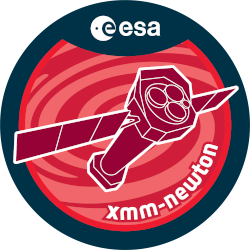

| Proposal ID | 040013 |
| Title | Shock heating and particle acceleration by the supersonic merger in Abell 3128 |
| Download Data Associated to the proposal | https://nxsa.esac.esa.int/nxsa-sl/servlet/data-action-aio?obsno=0400130101 |
| DOI | https://doi.org/10.5270/esa-ik7fxun |
| Principal Investigator, PI | Dr Jelle Kaastra |
| Abstract | We propose to observe the merging cluster A 3128 in the Horologium-Reticulumsupercluster for 100 ks. A 3128 has two X-ray cores. Observations indicate thatone core is moving at Mach number M~6 through the cluster. This high velocitycauses shocks, which heat the plasma and give rise to particle acceleration,which in turn can produce non-thermal emission. The high Mach number makes A3128 one of the best targets to investigate shocks created by supersonic infallvelocities in clusters of galaxies and to look for non-thermal emission. Thesuperior effective area, spectral resolution and sensitivity make XMM-Newton anideal instrument to look for the non-thermal emission and study the merger bymapping the temperature, density and metallicity distribution in the cluster. |
| Publications |
|
| Instrument | EMOS1, EMOS2, EPN, OM, RGS1, RGS2 |
| Temporal Coverage | 2006-05-29T17:54:16Z/2006-06-01T01:43:28Z |
| Version | 17.56_20190403_1200 |
| Mission Description | The European Space Agencys (ESA) X-ray Multi-Mirror Mission (XMM-Newton) was launched by an Ariane 504 on December 10th 1999. XMM-Newton is ESAs second cornerstone of the Horizon 2000 Science Programme. It carries 3 high throughput X-ray telescopes with an unprecedented effective area, and an optical monitor, the first flown on a X-ray observatory. The large collecting area and ability to make long uninterrupted exposures provide highly sensitive observations. Since Earths atmosphere blocks out all X-rays, only a telescope in space can detect and study celestial X-ray sources. The XMM-Newton mission is helping scientists to solve a number of cosmic mysteries, ranging from the enigmatic black holes to the origins of the Universe itself. Observing time on XMM-Newton is being made available to the scientific community, applying for observational periods on a competitive basis. |
| Creator Contact | https://www.cosmos.esa.int/web/xmm-newton/xmm-newton-helpdesk |
| Date Published | 2007-07-01T00:00:00Z |
| Last Update | 2025-08-04 |
| Keywords | "metallicity distribution", "Abell 3128", "XMM", "horologium reticulum supercluster", "shock heating", "supersonic infall velocities", "abell 3128", "spectral resolution", "particle acceleration", "nonthermal emission", "xray cores", "shoc created", "xmm newton", "superior effective", "supersonic merger", "XMM-Newton", "merging cluster", "ideal instrument", "velocity causes shoc" |
| Publisher And Registrant | European Space Agency |
| Credit Guidelines | European Space Agency, Dr Jelle Kaastra, 2007, 'Shock heating and particle acceleration by the supersonic merger in Abell 3128', 17.56_20190403_1200, European Space Agency, https://doi.org/10.5270/esa-ik7fxun |